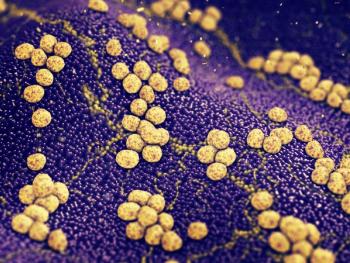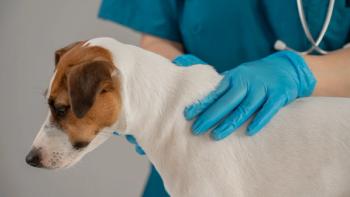
Just Ask the Expert: How do you combat acral lick dermatitis?
The main concern with this condition is a secondary bacterial folliculitis and furunculosis. The infection often requires six to 12 weeks of oral antibiotic therapy.
Dr. Spiegel welcomes dermatology questions from veterinarians and veterinary technicians.
with the subject line "Dermatology questions."
What is your diagnostic workup and treatment protocol for acral lick granuloma?
Ian Spiegel, VMD, MHS, DACVDAcral lick dermatitis, also known as an acral lick granuloma or an acral lick furunculosis, is a self-induced dermatologic condition in dogs that develops secondary to compulsive or excessive and chronic incessant licking in one or more areas. This dermatologic condition is one of the most challenging and frustrating that I manage. More than half of dogs with acral lick dermatitis are suspected to have concurrent fear- or anxiety-based conditions or both (e.g. separation anxiety, noise phobia, anxiety-related aggression).
The condition incites the affected patient to excessively lick an area or areas, causing hair loss and erosion of the superficial skin layers. The result is self-trauma that leads to a focal infection, and the consequence is even more licking. This cycle is thought to be further exacerbated by the idea that local cells or nerves that become damaged release endorphins that act not only as strong analgesics but provide a natural "high" and lead to affected patients licking more and more.
CLINICAL SIGNS AND DISEASE COURSE
Acral lick dermatitis lesions usually occur on the front or top portion of the lower limb over the carpus, metacarpus, tarsus, or metatarsus. The condition is often associated with an underlying allergy, a behavior abnormality, or arthritis. Most patients are presented with single unilateral lesions on the cranial carpus or metacarpus.
The constant licking and self-mutilation lead to inflammation of the skin, and, over time, the skin in that area becomes thickened (lichenified and fibrotic). Constant licking prevents the area from healing, and it may become erythematous, raised, and ulcerated. It is likely that the licking and the inflammation also cause the area to become pruritic, which leads to more frequent licking and perpetuates an itch-lick cycle. This self-trauma causes damage to and rupture of hair follicles (furunculosis), also leading to inflammation.
CAUSES
The act of excessive licking may be a compulsive disorder (displaced behavior) associated with stress (e.g. lengthy confinement, new child or pet, death in the family, moving, boredom), fear, or separation anxiety.
Other documented causes include ectoparasites (e.g. mites), cancer, orthopedic disorders or osteopathies (arthritis, joint disease, bone pain, implants or hardware), previous trauma or injury, foreign material (e.g.suture, grass awn, thistle spine, splinter, bee stinger, metal, gravel), neuropathy (e.g. neural entrapment, radial nerve tumors, sciatic nerve entrapment), and metabolic disease (e.g. hypothyroidism), or it may be idiopathic.
TREATMENT AND PROGNOSIS
The main concern with this condition is a secondary bacterial folliculitis and furunculosis. The infection often requires six to 12 weeks of oral antibiotic therapy.
The obsessive-compulsive behavior component of this condition is more challenging to manage. A behavior-modifying medication can be used (e.g.amitryptyline, fluoxetine, or clomipramine). And a behavior consultation may be indicated.
It may be necessary to initially deter the constant licking with a mechanical blocking device such as a special collar, muzzle, or bandage. Most dogs are able to remove socks and bandages. I often recommend a product that can be purchased from
While rarely recommended, laser surgery may be helpful in selected cases. The laser instrument is used to ablate affected tissue by vaporizing the surface layers and nerve tissue so that minimal sensation is perceived. Bleeding is minimal for this surgery. Other laser procedures can be performed (e.g. cold laser).
Acral lick granulomas are difficult to cure but are usually manageable. For many patients, a guarded prognosis for lesion resolution is often given. Continuous self-mutilation (licking and chewing) can prevent the lesions from healing. In some cases, this self-mutilation is severe enough to cause discomfort and possibly interfere with the patients' quality of life. While this is rarely a life-threatening condition, it is irritating for the dog and owner. Dogs that receive early and appropriate treatment have a much better chance for recovery than dogs with chronic advanced or severe conditions.
In summary, I usually start with oral antibiotics, oral corticosteroids (if not contraindicated), and a deterrent (topical or mechanical barrier). If there is a poor response, then I consider a behavior-modifying medication. If there is a good response, but then a relapse, I would be more likely to pursue an underlying allergy (e.g. allergy testing with or without cyclosporine treatment).
Ian Spiegel, VMD, MHS, DACVD
Red Bank Veterinary Hospital
197 Hance Ave.
Tinton Falls, NJ 07724
SUGGESTED READING
1. Seltzer JD, Spiegel IB. Acral lick dermatitis: causes and cures. DVM Newsmgazine 2007.
Newsletter
From exam room tips to practice management insights, get trusted veterinary news delivered straight to your inbox—subscribe to dvm360.




